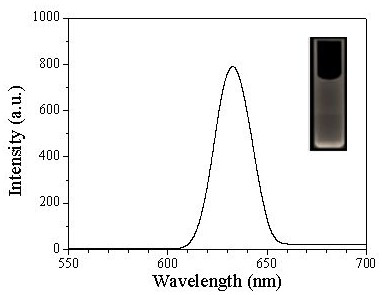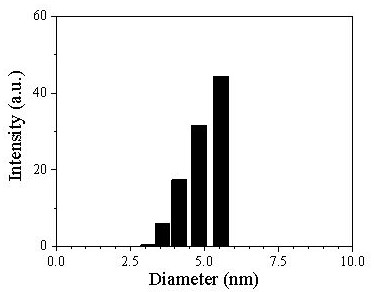Preparation method of graphene quantum dot fluorescent probe for paraquat detection
A technology of graphene quantum dots and fluorescent probes, applied in the field of materials science, can solve problems such as poor effect
- Summary
- Abstract
- Description
- Claims
- Application Information
AI Technical Summary
Problems solved by technology
Method used
Image
Examples
specific Embodiment approach
[0058] The specific embodiment: a kind of preparation method of the graphene quantum dot fluorescent probe that is used for paraquat detection, it is characterized in that: described graphene quantum dot fluorescent probe has the maximum emission wavelength of red emission spectrum band and is 630nm, and The characteristic absorption peak of the visible spectrum of paraquat with herbicidal activity is at 630nm. The fluorescence emission spectrum of the graphene quantum dot fluorescent probe overlaps with the maximum absorption wavelength of paraquat. According to the principle of fluorescence resonance energy transfer, graphene quantum dots The energy donor in the fluorescent group of the fluorescent probe produces fluorescence emission, and transfers the energy non-radiatively to the nearby energy acceptor paraquat molecule in the ground state through the interaction between dipoles and dipoles, resulting in graphite The fluorescent intensity of the graphene quantum dot fluore...
Embodiment
[0063] Example: Using cherry blossom leaves as raw materials, graphene quantum dot fluorescent probes with red emission spectrum can be prepared after microwave digestion.
[0064]The first step is the preparation of graphene quantum dot fluorescent probes with red emission spectrum: cut the green plant leaves into 1.5cm, soak them in 50 mL of absolute ethanol, then stir continuously at 500 rpm for 30min, let stand for 15min after stirring, and then Centrifuge the resulting solution at 8000rpm for 10min, take 40mL of supernatant, and rotate the supernatant to evaporate to obtain a muddy solid. Measure 5mL of water and add it to the muddy solid, and heat it in a 1000W microwave oven 5min, and finally add ethanol to dissolve to obtain a fluorescent probe with graphene quantum dots in the red emission spectrum;
[0065] The second step is the preparation of paraquat solution: weigh 2.572g of paraquat, place it in a 100mL volumetric flask, and pipette the concentration of 0.1 mol∙...
PUM
 Login to View More
Login to View More Abstract
Description
Claims
Application Information
 Login to View More
Login to View More - R&D
- Intellectual Property
- Life Sciences
- Materials
- Tech Scout
- Unparalleled Data Quality
- Higher Quality Content
- 60% Fewer Hallucinations
Browse by: Latest US Patents, China's latest patents, Technical Efficacy Thesaurus, Application Domain, Technology Topic, Popular Technical Reports.
© 2025 PatSnap. All rights reserved.Legal|Privacy policy|Modern Slavery Act Transparency Statement|Sitemap|About US| Contact US: help@patsnap.com



